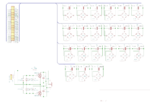Swend
Full Member level 4
- Joined
- May 14, 2019
- Messages
- 237
- Helped
- 10
- Reputation
- 20
- Reaction score
- 9
- Trophy points
- 18
- Location
- Roskilde, Denmark
- Activity points
- 2,304
Hi Easy peasy and FvM.
Thank you for your valuable input.
First let answer the question of how the drivers are isolated. All the drivers and the MCU are all powered from individual secondary windings on a toroid transformer.
The test situation is as follows. All IGBT's are OFF and stay OFF the entire time until I press a button which results in a single 500uS gate signal on all drivers. For this test I'm NOT pressing the button, just trying to crank up the HV.
Now if I just crank up until the power supply stops responding to me turning the knob, everything survives. So we have a situation where the power supply's can't deliver more current than it's designed for in this case up to 40mA, so where does these 40mA go? I measured 1mA through the entire stack, which makes the resistors hot to the touch. So I'm thinking if the reminding current is lost in the stack, I would surely hear, see and smell it.
In the next test I crank up until the power supply stops responding to me turning the knob, then I turn the knob back a little bit until voltage starts dropping. Then I press the button and turn all IGBT's ON - everything works just fine.
So what I'm trying to say is that it is hard for me to believe it's a breakdown of the drivers isolation barrier. During this testing I haven't blown up a single driver, only the IGBT's.
Thank you for your valuable input.
First let answer the question of how the drivers are isolated. All the drivers and the MCU are all powered from individual secondary windings on a toroid transformer.
The test situation is as follows. All IGBT's are OFF and stay OFF the entire time until I press a button which results in a single 500uS gate signal on all drivers. For this test I'm NOT pressing the button, just trying to crank up the HV.
Now if I just crank up until the power supply stops responding to me turning the knob, everything survives. So we have a situation where the power supply's can't deliver more current than it's designed for in this case up to 40mA, so where does these 40mA go? I measured 1mA through the entire stack, which makes the resistors hot to the touch. So I'm thinking if the reminding current is lost in the stack, I would surely hear, see and smell it.
In the next test I crank up until the power supply stops responding to me turning the knob, then I turn the knob back a little bit until voltage starts dropping. Then I press the button and turn all IGBT's ON - everything works just fine.
So what I'm trying to say is that it is hard for me to believe it's a breakdown of the drivers isolation barrier. During this testing I haven't blown up a single driver, only the IGBT's.

